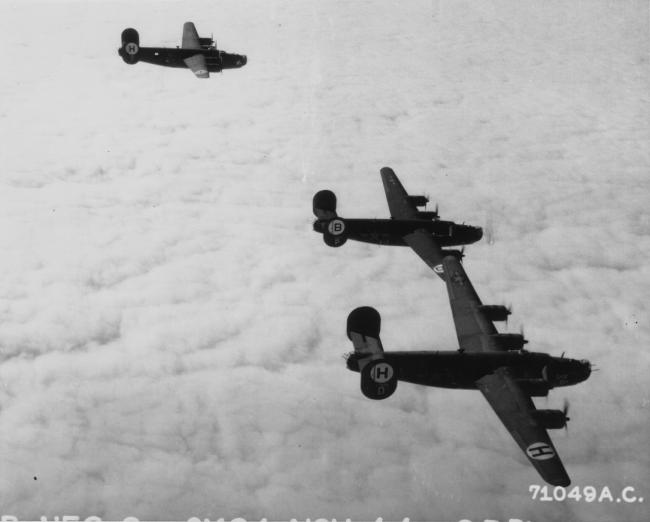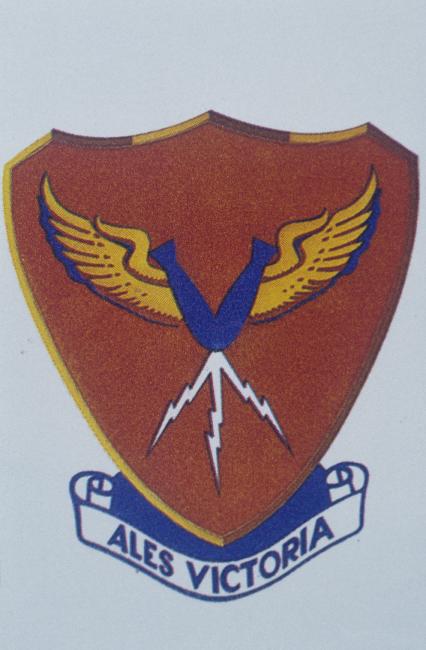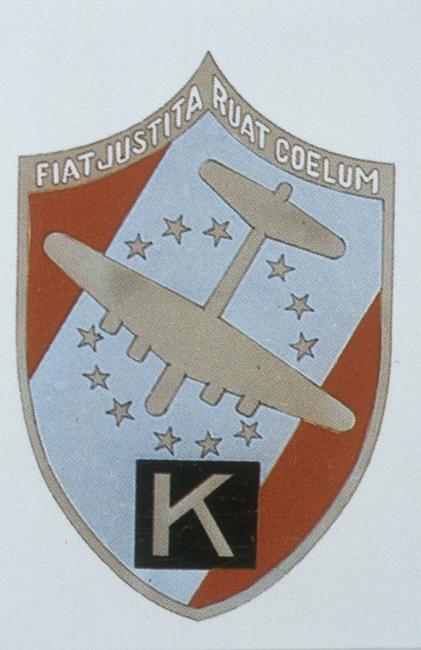412
14 June 1944
Object Number - UPL 34092 - "The entire landing area and runways are pitted with bomb craters at the Chateaudun airdrome in France. The most recent attack on this German...
Description
Mission #10. Bombed an airfield south of Brussels. Bob Martin flew in place of Hussong.
Mission Details
Description: ATTACK TARGETS OF OPPORTUNITY
Aircraft Type: B-24 Liberator
Notes: 5 B-24s use Azon missiles against targets of opportunity
Mission Statistics
- Tonnage Dropped: 12.5 T
Description: BOMB TARGETS OF OPPORTUNITY
Mission Statistics
- Tonnage Dropped: 12 T
Description: BOMB TARGETS OF OPPORTUNITY
Mission Statistics
- Tonnage Dropped: 41.5 T
BEAUVOIS (Primary)
Description: TRANSPORTATION TARGET
Aircraft Type: B-24 Liberator
![Three B-17 Flying Fortresses of the 94th Bomb Group are attacked by a Nazi Fighter aircraft during a mission. Printed caption on reverse of print: 'A-62641 USAF: Nazi fighter plane attacking Boeing B-17 "Flying Fortresses" during a bomb run over enemy installations somewhere in Europe, 10 September 1944. 100th[sic] Bomb Group, 3rd Bomb Division. U.S. Air Force Photo.'](https://assets.americanairmuseum.com/s3fs-public/styles/max_650x650/public/freeman/media-408505.jpg?itok=Hi-SN9sg)
- Unit Hierarchy: Division
- Air Force: Eighth Air Force
- Type Category: Combat organisation
Mission Statistics
- Tonnage Dropped: 125 T
- Aircraft sent: 50
BRETIGNY (Primary)
Description: AIRFIELD
Aircraft Type: B-17 Flying Fortress

- Unit Hierarchy: Division
- Air Force: Eighth Air Force
- Type Category: Bombardment
Mission Statistics
- Tonnage Dropped: 126.3 T
- Aircraft sent: 502
- Aircraft effective: 69
BRUSSELS/MELSBROEK (Primary)
Description: AIRFIELD
Aircraft Type: B-17 Flying Fortress
![Three B-17 Flying Fortresses of the 94th Bomb Group are attacked by a Nazi Fighter aircraft during a mission. Printed caption on reverse of print: 'A-62641 USAF: Nazi fighter plane attacking Boeing B-17 "Flying Fortresses" during a bomb run over enemy installations somewhere in Europe, 10 September 1944. 100th[sic] Bomb Group, 3rd Bomb Division. U.S. Air Force Photo.'](https://assets.americanairmuseum.com/s3fs-public/styles/max_650x650/public/freeman/media-408505.jpg?itok=Hi-SN9sg)
- Unit Hierarchy: Division
- Air Force: Eighth Air Force
- Type Category: Combat organisation
Mission Statistics
- Tonnage Dropped: 141.80
- Aircraft sent: 351
- Aircraft effective: 61
CALLAS TRES (Opportunistic)
Description: AIRFIELD
Aircraft Type: B-24 Liberator
![Three B-17 Flying Fortresses of the 94th Bomb Group are attacked by a Nazi Fighter aircraft during a mission. Printed caption on reverse of print: 'A-62641 USAF: Nazi fighter plane attacking Boeing B-17 "Flying Fortresses" during a bomb run over enemy installations somewhere in Europe, 10 September 1944. 100th[sic] Bomb Group, 3rd Bomb Division. U.S. Air Force Photo.'](https://assets.americanairmuseum.com/s3fs-public/styles/max_650x650/public/freeman/media-408505.jpg?itok=Hi-SN9sg)
- Unit Hierarchy: Division
- Air Force: Eighth Air Force
- Type Category: Combat organisation
Mission Statistics
- Tonnage Dropped: 31 T
- Aircraft sent: 191
- Aircraft effective: 12
CHATEAUDUN (Primary)
Description: AIRFIELD
Aircraft Type: B-24 Liberator
Notes: All the 2nd Bomb Division except the 445th Bomb Group took part. The attack on the oil refinery at Emmerich, Germany is the first time since 31 May 1944 that a target in Germany has been able to be bombed because of the weather.

- Unit Hierarchy: Division
- Air Force: Eighth Air Force
- Type Category: Combat organisation
Mission Statistics
- Tonnage Dropped: 215.3 T
- Aircraft sent: 466
- Aircraft effective: 103
- Aircraft damaged beyond repair: 33
CHIEVRES (Opportunistic)
Description: TRANSPORTATION TARGET
Aircraft Type: B-24 Liberator
![Three B-17 Flying Fortresses of the 94th Bomb Group are attacked by a Nazi Fighter aircraft during a mission. Printed caption on reverse of print: 'A-62641 USAF: Nazi fighter plane attacking Boeing B-17 "Flying Fortresses" during a bomb run over enemy installations somewhere in Europe, 10 September 1944. 100th[sic] Bomb Group, 3rd Bomb Division. U.S. Air Force Photo.'](https://assets.americanairmuseum.com/s3fs-public/styles/max_650x650/public/freeman/media-408505.jpg?itok=Hi-SN9sg)
- Unit Hierarchy: Division
- Air Force: Eighth Air Force
- Type Category: Combat organisation
Mission Statistics
- Tonnage Dropped: 214.30
- Aircraft sent: 191
- Aircraft effective: 70
COULOMMIERS (Primary)
Description: AIRFIELD
Mission Statistics
- Tonnage Dropped: 45.5 T
COXYDE (Opportunistic)
Description: AIRFIELD
Mission Statistics
- Tonnage Dropped: 17.5 T
CREIL (Opportunistic)
Description: AIRFIELD
Mission Statistics
- Tonnage Dropped: 45.7 T
CREIL (Primary)
Description: AIRFIELD
Mission Statistics
- Tonnage Dropped: 78.9 T
DENAIN DROUSEY (Opportunistic)
Description: TRANSPORTATION TARGET
Mission Statistics
- Tonnage Dropped: 7.6 T
DOMLEGER (Primary)
Description: INDUSTRIAL COMPLEX
Mission Statistics
- Tonnage Dropped: 44 T
EINDHOVEN (Primary)
Description: AIRFIELD
Mission Statistics
- Tonnage Dropped: 63 T
Description: OIL REFINERY
Mission Statistics
- Tonnage Dropped: 175.6 T
ETAMPES (Primary)
Description: AIRFIELD
Mission Statistics
- Tonnage Dropped: 87.7 T
FLORENNES (Primary)
Description: AIRFIELD
Mission Statistics
- Tonnage Dropped: 327.20
Description: TRANSPORTATION TARGET
Notes: 3rd Bomb Division B-24 Groups

- Unit Hierarchy: Group
- Air Force: Eighth Air Force
- Type Category: Bombardment

- Unit Hierarchy: Group
- Air Force: Eighth Air Force
- Type Category: Bombardment

- Unit Hierarchy: Group
- Air Force: Eighth Air Force
- Type Category: Bombardment

- Unit Hierarchy: Group
- Air Force: Eighth Air Force
- Type Category: Bombardment

- Unit Hierarchy: Group
- Air Force: Eighth Air Force
- Type Category: Bombardment
Mission Statistics
- Tonnage Dropped: 3.5 T
HAMM-SUR-SOMME (Primary)
Description: BRIDGE
Mission Statistics
- Tonnage Dropped: 17.5 T
LAON/ATHIES (Primary)
Description: AIRFIELD
Mission Statistics
- Tonnage Dropped: 99 T
Description: AIRFIELD
Mission Statistics
- Tonnage Dropped: 43.50
LILLE/VENDEVILLE (Primary)
Description: AIRFIELD
Mission Statistics
- Tonnage Dropped: 151.7 T
MELUN (Primary)
Description: AIRFIELD
Mission Statistics
- Tonnage Dropped: 82 T
Description: TROOP SUPPRESSION NEAR BEACHES
Mission Statistics
- Tonnage Dropped: 10 T
ORLEANS/BRICY (Primary)
Description: AIRFIELD
Mission Statistics
- Tonnage Dropped: 182 T
PARIS/LE BOURGET (Primary)
Description: AIRFIELD
Aircraft Type: B-24 Liberator
Notes: Bad weather over Germany continues to suspend strategic operations. Thus, the 8th Air Force takes on tactical missions against airfield targets in France. 457th BG - MISSION NO. 66 - LE BOURGET, MELUN, VILLAROCHE, FRANCE 14 JUNE, 1944 Eighth Air Force reconnaissance revealed the Luftwaffe had committed a large number of fighters to the western front with principal bases to be in the larger airdromes in the Paris vicinity. Over 1500 heavy bombers were dispatched against eleven airfields in France and four in Belgium. The 457th committed sixty aircraft to the endeavor. It provided the entire 94th E Combat Wing, composed of thirty-six ships, to attack the Villaroche airfield located 20 miles southeast of Pans, near Melun. In addition, twelve ship high boxes were supplied to the 94th B and D Combat Wings, and were assigned to bomb the Le Bourget airdrome just north of Paris. Fifty-eight aircraft were airborne. Lt. Col. Raymond L. Cobb was Air Commander of the lead E box with Lt. Malcolm E. Johnson as pilot. Major Theodore C. Hoffman led the high E box with Captain Donald E. Lady as pilot. Captain Wilbur D. Snow led the low E box with Lt. Mark R. Belcher as pilot. Major Jacob M. Dickinson led the high B box with Captain Edward B. Dozier as pilot. Major Fred A. Spencer led the high D box with Lt. Vinton H. Mays as pilot. The 94th B Wing was third in the 1st Division formation of fourteen Combat Wings. As the Wing approached the target on the bomb run, heavy and accurate flak was encountered. The lead ship took a direct burst of flak under its tail. Just after bombs away a series of flak bursts hit the low squadron, causing serious damage to three planes. The craft piloted by Lt. Charles R. Blackwell, on his 29th mission, was hit by a burst of flak, which knocked out three engines, caused the ship to drop out of formation and the crew to parachute from the craft. The craft of Lt. William F. Rogers, on his 29th mission, took a burst of flak, knocking out No. 4 engine, piercing the gas tank and causing the mount of No. 3 engine to melt. The engine dropped off the plane. The craft dropped out of formation, went into a glide and the crew parachuted to the ground. Lt. James P. LaPaze's craft took a hit underneath the ship, remained with the formation to the English Channel, where the crew bailed out. Shortly thereafter, the ship exploded in mid- air. Four crewmen, including Lt. LaPaze, were rescued by AirL Sea Rescue. The 94th E Combat Wing, thirteenth in the Division formation, started the bomb run at Villaroche, abandoned it and started thirty-five minutes of 360 degree turns to the right. While the formation was doing a 360 degree turn, ten to fifteen enemy fighters made a head-on pass through the formation. The Deputy Wing lead plane was hit, knocking out an engine. As it neared the bomb run, a hit by flak started a fire in the flares behind the cockpit. The rudder control cables were destroyed and the oxygen system was out. The pilot pushed the bail out signal, and thinking all the crew were out, exited the craft through the bomb bay. The escape hatch in the nose would not open and the crew in the rear did not receive the bail out signal due to the communication system being inoperative. Captain Raymond A. Syptak, flying as Deputy Wing Commander, took over the controls, brought the plane out of a dive, maneuvered back into position and completed the mission. On the return home a second engine went out, but he piloted the ship back to the Base. For his gallantry in action, Captain Syptak was decorated with the Silver Star. The citation which accompanied his decoration read in part: "For gallantry in action against the enemy while leading a group of B- 17 Flying Fortresses on a bombardment mission over enemy occupied territory. Just prior to reaching the target, enemy fighters made a savage attack on his aircraft, knocking out one engine, damaging a second engine and completely destroying a large number of instruments. Expertly utilizing the power of the remaining engines, Major Syptak, determined to complete the mission, maneuvered back into the lead position and continued on the bombing run. Over the target area, a direct flak hit destroyed the rudder control cables, punctured the oxygen supply tanks and started a raging fire inside the plane. Major Syptak ordered the crew to bail out. Unable to open the escape hatch in the nose compartment, Major Syptak, weak from lack of oxygen, struggled back to the cockpit and brought the stricken plane under control, while the engineer succeeded in extinguishing the flames. When the engineer's clothes caught fire, Major Syptak put out the flames with his bare hands. During the return journey a second engine went out entirely, but despite this added handicap, he piloted the aircraft back to England and made a safe landing. The gallantry, indomitable fighting spirit and superior flying skill displayed by Major Syptak, undoubtedly saved the lives of the crewmen trapped in the burning aircraft." The engineer referred to in Captain Syptak's citation was the flight engineer, top turret gunner, Technical Sergeant Paul A. Birchen. Working without oxygen he picked up burning flares and oxygen tanks and threw them out of the plane, ripped burning wires from a junction box and beat out flames with his flak suit until he lost consciousness from lack of oxygen. After being revived, he returned to his task of fighting the flames and labored valiantly until the fire was extinguished. He then repaired some of the damage to the rudder control cable, which contributed to the success of the return to England and for the Fortress to land safely. For his gallantry inaction, Sgt. Birchen was also awarded the Silver Star. During the bomb run, the lead ship of the E box, piloted by Lt. Malcolm E. Johnson and with the Wing Commander Lt. Col. Cobb on board, took a direct hit by flak, zoomed up through the high squadron, then spun down out of control before exploding. While in the process of making the 360, the craft piloted by Lt. Roy W. Allen, the third aircraft in the lead squadron, was hit by fighters, two engines were knocked out and the ship was set afire. The crew successfully bailed out except for the bombardier, who was shot in the air as he descended. The box lead was taken over by Lt. Benny M. Flowers, but it was too late to sight and drop bombs. The low and high boxes experienced difficulty in finding the target area. The D box approached Paris after the B box. The target appeared cloud covered and a 360 degree turn was made. The same conditions existed so a target of opportunity was sought. However, on the way around Le Bourget, the target was sighted and bombed. Flak was light over the target area but at Dieppe on the way out, flak damage was encountered. A total of 27 aircraft sustained damage. For the day, bombing results were not good and the 457th had experienced another rough mission. Lt. Charles R. Blackwell was the copilot on the Dickinson crew, one of the four original crews. He was checked out as a first pilot at Glatton and during one period flew ten missions in 17 days. With the help of the French underground he evaded capture and was liberated by advancing Allied troops. Lt. Rogers also evaded capture. Lt. Allen attempted to evade capture and lived with the French underground until~ captured. He was sent to Buchenwald as a spy and saboteur before being sent to a POW camp. The following crews were lost on this date: Lt Charles R. Blackwell Lt William F. Rogers Lt James P.LaPaze Lt Malcome E. Johnson Lt Roy W. Allen

- Unit Hierarchy: Division
- Air Force: Eighth Air Force
- Type Category: Bombardment

- Unit Hierarchy: Group
- Air Force: Eighth Air Force
- Type Category: Bombardment
Mission Statistics
- Tonnage Dropped: 322.2 T
Description: AIRFIELD
Notes: 3rd Bomb Division B-17 Groups
![Three airmen of the 100th Bomb Group, Lieutenant Kenneth Menzie, Lieutenant Donald Strout and Lieutenant Norman Scott, plan the route they will take during the next mission in their B-17 Flying Fortress (serial number 42-30380). Image stamped on reverse: 'Reviewed and passed U.S. Army 23 Aug 1943 Press Censor E.T.O. U.S.A.' [stamp]'. Passed for publication 23 August 1943 INTLD 16 General Section Press Censorship Bureau '[stamp], 'Associated Press' [stamp] and '280035.' [Censor no.] Printed caption on reve](https://assets.americanairmuseum.com/s3fs-public/styles/max_650x650/public/freeman/media-378743.jpg?itok=oPPVVi6c)
- Unit Hierarchy: Group
- Air Force: Eighth Air Force
- Type Category: Bombardment

- Unit Hierarchy: Group
- Air Force: Eighth Air Force
- Type Category: Bombardment

- Unit Hierarchy: Group
- Air Force: Eighth Air Force
- Type Category: Bombardment

- Unit Hierarchy: Group
- Air Force: Eighth Air Force
- Type Category: Bombardment

- Unit Hierarchy: Group
- Air Force: Eighth Air Force
- Type Category: Bombardment
Mission Statistics
- Tonnage Dropped: 70.30
Connections
See how this entry relates to other items in the archive by exploring the connections below.
People

- Military/Civilian/Mascot: Military
- Nationality: American
- Unit: 492nd Bomb Group 856th Bomb Squadron
- Service Numbers: O-663450
- Highest Rank: First Lieutenant
- Role/Job: Pilot

- Military/Civilian/Mascot: Military
- Nationality: American
- Unit: 401st Bomb Group 612th Bomb Squadron
- Service Numbers: 36215923 / O-692248
- Highest Rank: Second Lieutenant
- Role/Job: Navigator
- Military/Civilian/Mascot: Military
- Nationality: American
- Unit: 401st Bomb Group 615th Bomb Squadron
- Service Numbers: 06966455
- Highest Rank: Staff Sergeant
- Role/Job: Waist Gunner

- Military/Civilian/Mascot: Military
- Nationality: American
- Unit: 401st Bomb Group 615th Bomb Squadron
- Highest Rank: Technical Sergeant
- Role/Job: Radio Operator
- Military/Civilian/Mascot: Military
- Nationality: American
- Unit: 384th Bomb Group 545th Bomb Squadron
- Service Numbers: 33574325
- Highest Rank: Staff Sergeant
- Role/Job: Top Turret Gunner / Flight Engineer
Aircraft
- Aircraft Type: B-24 Liberator
- Unit: 392nd Bomb Group 578th Bomb Squadron

- Aircraft Type: B-24 Liberator
- Nicknames: Rough Riders
- Unit: 458th Bomb Group 755th Bomb Squadron
- Aircraft Type: B-24 Liberator
- Nicknames: Big Dick Hard To Hit
- Unit: 458th Bomb Group 755th Bomb Squadron

- Aircraft Type: B-17 Flying Fortress
- Nicknames: Diana Queen Of The Chase
- Unit: 401st Bomb Group 612th Bomb Squadron

- Aircraft Type: B-17 Flying Fortress
- Nicknames: Spam-O-Liner
- Unit: 545th Bomb Squadron 384th Bomb Group
Revisions
Mission details added courtesy of Diane Elizabeth Reese from 457th Bomb Group Mission Documents. http://www.457thbombgroup.org/
Added B-24 to aircraft type based on information in Freeman, Mighty Eighth War Diary, p. 266.
Lee Cunningham, 8th Air Force missions research database / Stan Bishop's 'Losses of the US 8th and 9th Air Forces', the Combat Chronology of the US Army Air Forces and the work of Roger Freeman including the 'Mighty Eighth War Diary'.



